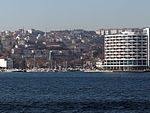2008 United States consulate in Istanbul attack
2000s in Istanbul2008 in TurkeyAttacks on diplomatic missions in TurkeyAttacks on diplomatic missions of the United StatesHistory of the Republic of Turkey ... and 5 more
Mass murder in 2008Presidency of George W. BushTerrorist incidents in IstanbulTerrorist incidents in Turkey in 2008Turkey–United States relations

In the morning hours on July 9, 2008, an attack on the Consulate General of the United States, Istanbul resulted in the deaths of the three gunmen and three Turkish National Police officers. The attack occurred at a time when the facility was at full function. It is the responsibility of the host state to take care of security as per Article 22 of the Vienna Convention on Diplomatic Relations.
Excerpt from the Wikipedia article 2008 United States consulate in Istanbul attack (License: CC BY-SA 3.0, Authors, Images).2008 United States consulate in Istanbul attack
Sarıyer Caddesi,
Geographical coordinates (GPS) Address Phone number Website Nearby Places Show on map
Geographical coordinates (GPS)
| Latitude | Longitude |
|---|---|
| N 41.117274 ° | E 29.046867 ° |
Address
ABD Başkonsolosluğu
Sarıyer Caddesi 75
34460 , İstinye Mahallesi
Turkey
Open on Google Maps




